|
|
|
Sort Order |
|
|
|
Items / Page
|
|
|
|
|
|
|
| Srl | Item |
| 1 |
ID:
182576


|
|
|
|
|
| Summary/Abstract |
Borderland areas separating the state of Sarawak (Malaysia) and West Kalimantan (Indonesia) have long been a security concern for the Sarawak State Government. In general, such areas emerge as cross-border crime scenes, where many cases are constantly reported to the relevant security authorities. Despite the perseverance of Malaysia in enhancing border security, particularly that of the Sarawak state government, a discourse centred on state-centric security on people’s security issues in the affected area remains lacking. Border communities are rarely asked about matters of personal safety which can shed some light on the depiction of borderlands as insecure regions threatening human security. Although calls to secure national borders are evident, the perspectives of border communities are often discounted. This paper aims to highlight the importance of an empirical study in understanding human security from a spatial context of a borderland. By analysing the perceptions of people residing close to the border, this study contextualises human (in)security focusing on border community narratives and experiences and reflects on how borders impact people’s daily life. The analysis thematically underlined the value of including people’s collective experiences gathered through focus group discussions (FGDs) among the border communities of Danau Melikin, Serian, Sarawak. The findings offered insights into the population’s mental state and contributed to the current understanding of human (in)security from a bottom-up perspective. Accordingly, the study reported that people’s perception of threats and fear resulted from cross-border threats, where the profound effects related to human security threats were mostly influenced by border vulnerabilities. In this vein, the border as a ‘space’ was essential in influencing insecurity among the border communities of Danau Melikin, Serian.
|
|
|
|
|
|
|
|
|
|
|
|
|
|
|
|
| 2 |
ID:
159386
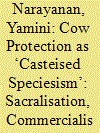

|
|
|
|
|
| Summary/Abstract |
Offering a more-than-human sociological analysis of cow protectionism in India, this article argues that the discourse renders bovines vulnerable because it reinforces two compatible and comparable oppressions: ‘casteism’ and ‘speciesism’. It privileges upper-caste Hindu nationalists whose identity politics are intertwined with sacralising native cows and their milk, producing ‘casteised speciesism’. Through interviews with experts engaged in cow protection, the article demonstrates that native Indian breeds are burdened with representing Hindu purity, while buffalo and crossbred or Jersey cows are exposed to exploitation and oppression comparable to the situation faced by Dalits. To be meaningful for the animals, protectionism needs to be embedded in an animal rights movement that employs vulnerabilities as a framework to deconstruct the oppression of non-humans.
|
|
|
|
|
|
|
|
|
|
|
|
|
|
|
|
| 3 |
ID:
184187
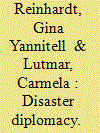

|
|
|
|
|
| Summary/Abstract |
The COVID-19 pandemic has drawn worldwide attention to the difficulties inherent in managing disasters. Scholars across disciplines have been forced to consider the impact disasters have on interstate relations, state resilience, patterns of violence and hostility, and the vulnerabilities that condition conflict. This special issue offers new insights to help disentangle the relationship between disasters, conflict, and cooperation, by adhering to a three-pronged theoretical framework. First, all pieces in this issue are underpinned by a unified understanding of disasters as endogenous social phenomena. Second, we acknowledge that disasters occur as processes rather than discrete events. Finally, we explore the possibility that disasters and conflict are co-determined by a common set of factors. The articles herein were chosen not only because they advance academic thought about the disaster–conflict nexus, but also because of their potential to advance the practical impact of this line of research on the global conflict and disaster landscape. We highlight the relevance of this special issue for further work investigating the effects of conflict on disasters and the relationship between the hazards cycle process and patterns of violence and hostility, as well as the implications of adopting this suggested framework for policymaking and data collection.
|
|
|
|
|
|
|
|
|
|
|
|
|
|
|
|
| 4 |
ID:
139424
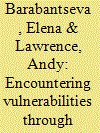

|
|
|
|
|
| Summary/Abstract |
In this article we discuss the potential of observational and participatory filmmaking methods to both explore and represent a research subject through a documentary film. We position our project ‘British Born Chinese’ about the experiences of the second generation of Chinese migrants in relation to other recent audio-visual interventions in IR, and present our methodological approach of observational and dialogical engagement with participants and the ethics of representation related to it. In doing this, we explore the potential of audio-visual research to go beyond identity-based forms of inquiries concerning, in particular, migrant and diasporic experiences. Our aim is to develop a situated and contextualised understanding of how and under what conditions individuals resort to racialised forms of belonging. We consider the promise and limitations of observational filmmaking to depart from the structures of representation to evoke alternative solidarities around vulnerability.
|
|
|
|
|
|
|
|
|
|
|
|
|
|
|
|
| 5 |
ID:
165070
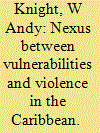

|
|
|
|
|
| Summary/Abstract |
This article analyses the nexus between the Caribbean’s manifold vulnerabilities and the direct and structural violence evident throughout the region’s history. It argues that Caribbean states are threatened not only by direct violence but also by the structural violence permeating in impoverished and marginalised sectors of the state–society complex. Both forms of violence are attributable to the historical legacy of colonisation, to US paternalism and hegemonic dominance in the post-colonial era, and to the persistence of the coloniality of power, even after Caribbean states won their independence from European imperial powers. Today, the region is, per capita, one of the most violent areas on the globe. Evidence of concatenated violence is growing across this region, demonstrating the difficulty small underdeveloped states have in addressing threats to their security, independence, economic viability, and continued existence in the intermestic environment within which they operate.
|
|
|
|
|
|
|
|
|
|
|
|
|
|
|
|
| 6 |
ID:
178782
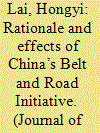

|
|
|
|
|
| Summary/Abstract |
The existing literature suggests that China’s rationale for the belt and road initiative was to stimulate infrastructural investment abroad and thus economic growth at home, foster economic ties with Eurasia, and counter the US pivot to Asia. Employing a domestic political economy perspective, this article suggests that the Belt and Road Initiative (BRI) aimed to address China’s three following vulnerabilities that could derail its economic growth and threaten its political regime—industrial surplus capacity, massive imports of energy through maritime transport instead of safer land routes, and under-development of the western region. Addressing these vulnerabilities helps to sustain China’s economic model characterised by heavy reliance on investment and exports, protection of state firms, and massive energy input. Post-2012 data suggest that the BRI has partially mitigated these three vulnerabilities.
|
|
|
|
|
|
|
|
|
|
|
|
|
|
|
|
|
|
|
|
|